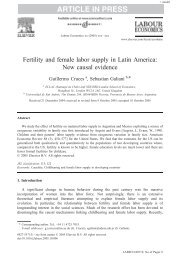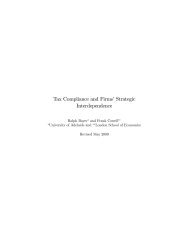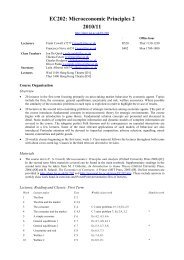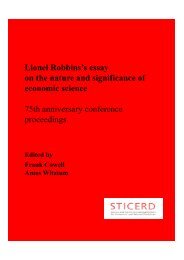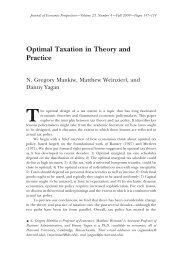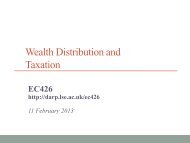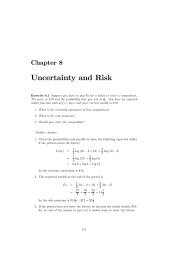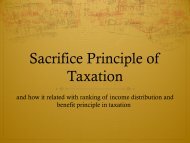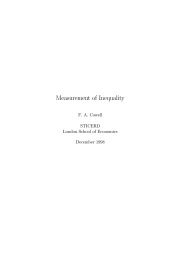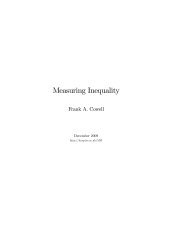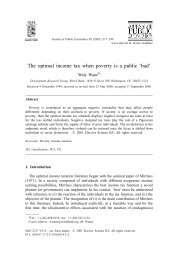You also want an ePaper? Increase the reach of your titles
YUMPU automatically turns print PDFs into web optimized ePapers that Google loves.
26 CHAPTER 2. CHARTING INEQUALITYas the ratio of the shaded area in Figure 2.4 to the area OCD. There is avariety of equivalent ways of de…ning G; but perhaps the easiest de…nition is asthe average di¤erence between all possible pairs of incomes in the population,expressed as a proportion of total income: see pages 151 and 153 for a formalde…nition. The main disadvantage of G is that it places a rather curious implicitrelative value on changes that may occur in di¤erent parts of the distribution.An income transfer from a relatively rich person to a person with £ x less hasa much greater e¤ect on G if the two persons are near the middle rather thanat either end of the parade. 3 So, consider transferring £ 1 from a person with£ 10 100 to a person with £ 10 000. This has a much greater e¤ect on reducingG than transferring £ 1 from a person with £ 1 100 to one with £ 1 000 or thantransferring £ 1 from a person with £ 100 100 to a person with £ 100 000. Thisvaluation may be desirable, but it is not obvious that it is desirable: this pointabout the valuation of transfers is discussed more fully in Chapter 3 once wehave discussed social welfare explicitly.Other inequality measures can be derived from the Lorenz curve in Figure2.4. Two have been suggested in connection with the problem of measuringinequality in the distribution of power, as re‡ected in voting strength. Firstly,consider the income level y 0 at which half the national cake has been distributedto the parade; i.e. (y 0 ) = 1 2. Then de…ne the minimal majority inequalitymeasure as F (y 0 ), which is the distance OH. If is reinterpreted as the proportionof seats in an elected assembly where the votes are spread unevenlyamong the constituencies as re‡ected by the Lorenz curve, and if F is reinterpretedas a proportion of the electorate, then 1 F (y 0 ) represents the smallestproportion of the electorate that can secure a majority in the elected assembly.Secondly, we have the equal shares coe¢ cient, de…ned as F (y): the proportionof the population that has income y or less (the distance OB), or the proportionof the population that has “average voting strength” or less. Clearly, eitherof these measures as applied to the distribution of income or wealth is subjectto essentially the same criticism as the relative mean deviation: they are insensitiveto transfers among members of the Parade on the same side of theperson with income y 0 (in the case of the minimal majority measure) or y (theequal shares coe¢ cient): in e¤ect they measure changes in inequality by onlyrecording transfers between two broadly based groups.Now let us consider Figures 2.2 and 2.5: the frequency distribution and itslog-transformation. An obvious suggestion is to measure inequality in the sameway as statisticians measure dispersion of any frequency distribution. In thisapplication, the usual method would involve measuring the distance between3 To see why, check the de…nition of G on page 151 and note the formula for the “TransferE¤ect” (right-hand column). Now imagine persons i and j located at two points y i and y j , agiven distance x apart, along the fence described on page 18; if there are lots of other personsin the part of the …eld between those two points then the transfer-e¤ect formula tells us thatthe impact of a transfer from i to j will be large (F (y j ) F (y i ) is a large number) and viceversa. It so happens that real-world frequency distributions of income look like that in Figure2.2 (with a peak in the mid-income range rather than at either end), so that two incomereceivers, £ 100 apart, have many people between them if they are located in the mid-incomerange but rather few people between them if located at one end or other.



